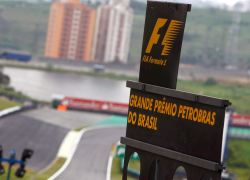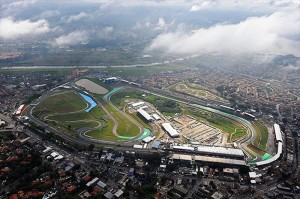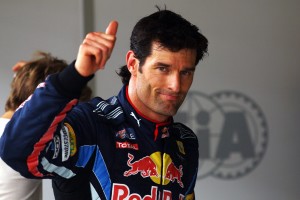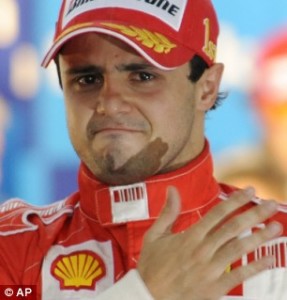
Transformation and evolution are as much a part of every Formula 1 season as the champagne flavoured victories and those breathtaking flashes of brilliance. The 2013 Brazilian grand prix will be more than a race, it will be the end of an era.
The South American city of Sao Paulo has within its hills one of the most historic racing circuits in all of motorsport. Several world titles have been clinched on its hallowed ground including those of Fernando Alonso, Kimi Raikkonen, Lewis Hamilton, Jenson Button and most recently Sebastian Vettel. The original circuit layout stretched to nearly eight kilometres with twenty-six turns with a lap record of 2:21.40 held by Jean-Pierre Jabouille. However, the circuit was streamlined in 1990 to the 4.3 km lap that is now familiar as the Interlagos circuit. Despite the shortened lap the anti-clockwise circuit is still a commanding venue with a distinctive challenge. The track is best known for its high speed sectors which are separated by twisty in-field section that requires good grip and stability from the car. The altitude of Interlagos additionally provides a unique challenge for the engines.
“Sao Paulo is around 800m above sea level, which has a big impact on the power of the engine. As the altitude increases the air pressure drops and the air is thinner with a lower oxygen content,” said Renault Sport F1 head of track operations Remi Taffin. “For every 100m the engine loses around 1 percent of its potential power output, meaning the RS27 will produce around 8 percent less power than at a sea-level race such as Korea.”
 But Brazil is more than just the Interlagos circuit. The country’s list of motorsport greats runs from Emerson Fittippaldi to three time champion Nelson Piquet to the transcendent Ayrton Senna. More recently Rubens Barrichello and Felipe Massa has enjoyed the fervent support of the Brazilian fans. “The passion of the Brazilian fans is amazing and it’s fantastic to see their support over the weekend,” said Lewis Hamilton.
But Brazil is more than just the Interlagos circuit. The country’s list of motorsport greats runs from Emerson Fittippaldi to three time champion Nelson Piquet to the transcendent Ayrton Senna. More recently Rubens Barrichello and Felipe Massa has enjoyed the fervent support of the Brazilian fans. “The passion of the Brazilian fans is amazing and it’s fantastic to see their support over the weekend,” said Lewis Hamilton.
The weather around the Autodromo Carlos Pace has a tendency to dramatically veer to both ends of the extreme. Track temperatures of 63 degress Celcuis has been recorded here in the past and on the other end of the scale epic levels of rain is nothing spectators and drivers havent seen before. The forecast for this weekend is fickle at best with some rain predicted during the weekend. Given the dominance of Sebastian Vettel and Red Bull several drivers will be hoping for the unknown weather element to shake up the pack. “The weather forecast for Interlagos looks interesting this weekend and if it does rain, that would be a good opportunity for us as our car is generally quick in the wet,” said Mercedes driver Nico Rosberg.
When the chequered flag falls after 71 laps of Sunday’s Brazilian grand prix it will bring with the end of an era. Twelve years ago an Aussie named Mark Webber started his first Formula 1 career behind the wheel of a Minardi. He scored points on debut at his home race but this was only to be cusp of what would become a great Formula 1 career. Webber joined Jaguar for the 2003 and 2004 season and qualified a career best second at the 2004 Malaysian grand prix. In 2005 Webber joined the Williams team with whom he would record several points finishes. The Red Bull partnership would commence in 2007 and be highlighted by several sublime victories. Webber’s first race victory at the 2009 German GP saw the Aussie deliver one of the most memorable drives of his career.
Webber has since won eight more races and through all of them he has been the straight-talking Aussie that many have to revere as one of the greatest racers Australia has produced. There aren’t many people who wouldn’t want to see Webber on the top step of the podium for the final time this weekend. Few people have raced and conducted themselves with more integrity than Mark Webber and whatever may happen AussieGrit and his tenacious character will be remembered in Formula 1 circles for some time to come.
 Ferrari bid farewell to Felipe Massa this weekend after eight seasons. Eleven race victories and an achingly close championship battle in 2008 tells the story of a glittering Ferrari career for Felipe Massa. At some points there were few drivers could match the Brazilian in terms of pace and he all but owned the Bahrain and Turkish grand prix circuits; winning at Istanbul three consecutive times. The memorable moments of Massa’s career with Ferrari have been etched into Formula 1 history not least of all being his emotional victory at the 2006 Brazilian GP. Massa became the first Brazilian driver since Ayrton Senna in 1993 to win at Interlagos. Felipe Massa repeated victory at his home race in 2008 as he came perilously close to becoming the Formula 1 world champion. But gracious in defeat to Lewis Hamilton Massa dedicated his victory to the fans. Massa starts the next chapter of his Formula 1 career as a Williams driver in 2014. He will unquestionably be a great asset to his new team.
Ferrari bid farewell to Felipe Massa this weekend after eight seasons. Eleven race victories and an achingly close championship battle in 2008 tells the story of a glittering Ferrari career for Felipe Massa. At some points there were few drivers could match the Brazilian in terms of pace and he all but owned the Bahrain and Turkish grand prix circuits; winning at Istanbul three consecutive times. The memorable moments of Massa’s career with Ferrari have been etched into Formula 1 history not least of all being his emotional victory at the 2006 Brazilian GP. Massa became the first Brazilian driver since Ayrton Senna in 1993 to win at Interlagos. Felipe Massa repeated victory at his home race in 2008 as he came perilously close to becoming the Formula 1 world champion. But gracious in defeat to Lewis Hamilton Massa dedicated his victory to the fans. Massa starts the next chapter of his Formula 1 career as a Williams driver in 2014. He will unquestionably be a great asset to his new team.
The 2013 Brazilian grand prix will mark the end of the V8 engine era after eight seasons in Formula 1. Fernando Alonso became the first ever V8 champion in 2006. French engine manufacturer Renault will end the V8 era as the most successful manufacturer with five constructor’s and five driver’s world championship titles. The Renault engine annihilated the competition with 59 wins, 65 pole positions and 55 fastest laps.
The conclusion of the 2013 season brings with it the end of an era as we bid farewell to Mark Webber and the V8 engine. There is no more fitting place to do so than a magical racing circuit named Interlagos.
Photo credits:
lotusf1team.com
Daily Mail


